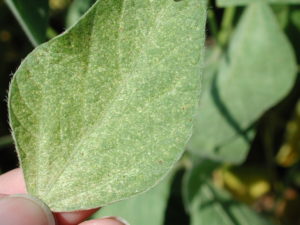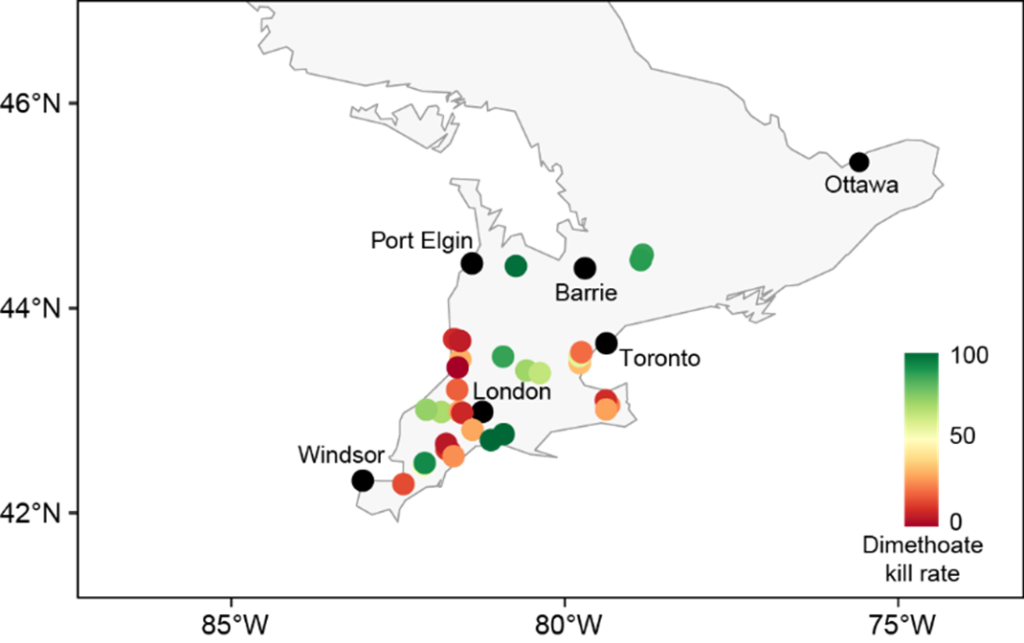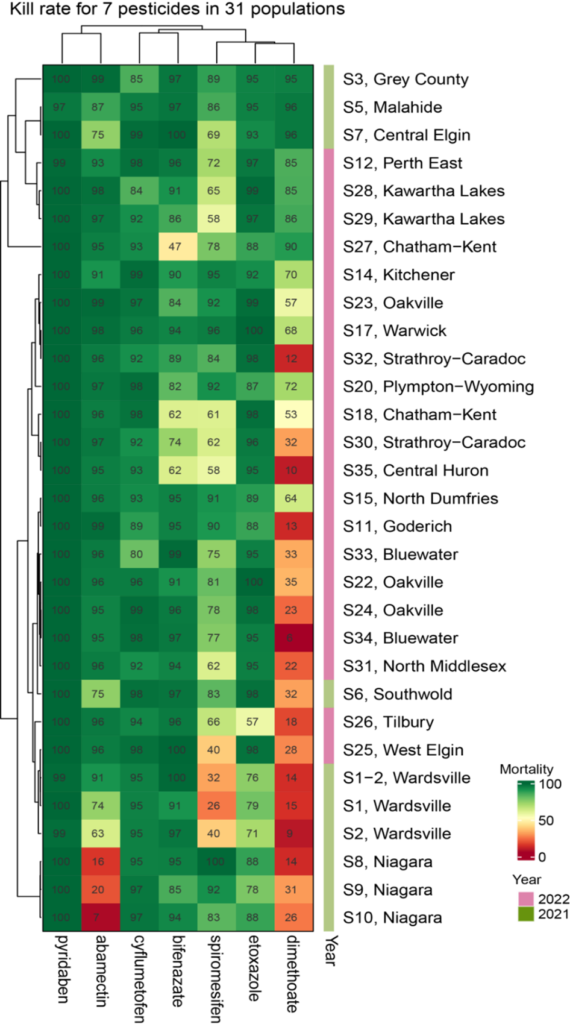Lack of rains and hot temperatures have two spotted spider mites (TSSM) exploding in some fields. Scouting soybeans and dry beans frequently for TSSM this time of year is important, as infestations tend to be noticed too late from the road when management was required much earlier. Mite infestations typically start on the fields edge, especially close to freshly cut ditch banks and road sides or next to recently harvested wheat fields. Look for plants that are yellowing or look drought stressed or sand blasted. Signs of stippling (white or yellow dots) on the upper leaf surface indicates mite feeding. Turn the leaves over and look for webbing and tiny dots moving around. Using a hand lens helps you to see the actual mites on the undersides of the leaves. Plan to scout fields that you suspect have mites last in your route, so you don’t carry mites into the next field you enter.

Four or more mites per leaflet or one severely damaged leaf per plant prior to pod fill indicates that control is necessary. The economic threshold is reached if the stippling on the plants look like Level 3 in the picture below. Stippling found in on leaves within mid-canopy or above are signs that mite infestations are reaching threshold. Spot treatments can be effective prior to wind events, if mites are only found at the fields’ edge or in a limited number of pockets in the field.

As for control, dimethoate might work in some fields but our research with Western University and AAFC-London shows many fields have populations that are resistant to Cygon and Lagon. Results from bioassays conducted on TSSM populations collected in soybean fields across Ontario show the prevalence of dimethoate (Cygon or Lagon) resistance in some areas. Out of 31 fields tested in 2021 and 2022, 18 fields or 58% of sites were found to have resistant TSSM populations (Figure 1). Fields with dark green dots in the map had TSSM populations that were still susceptible to dimethoate (100% kill), while fields with yellow (50% killed), orange or red (0% killed) dots had populations that were only partially killed or were fully resistant. Soybean fields close to one another tend to have similar levels of resistance. Fields in Grey County and Kawartha Lakes and a few fields in Perth and Central Elgin were still susceptible to dimethoate. But several fields in parts of Huron, Niagara, Oxford, Middlesex, West Elgin and Chatham-Kent had populations that were quite tolerant to dimethoate.

Figure 1. Levels of dimethoate effectiveness in two-spotted spider mite populations collected in 31 soybean fields in 2021 and 2022.
As part of the same study, other miticides used in horticultural crops were tested against these TSSM populations. These include the active ingredients abamectin, bifenazate, cyflumetofen, etoxazole, pyridaben and spiromesifen. Spiromesifen (as Oberon) is currently registered for TSSM control on corn and dry beans but not soybeans in Canada. The heatmap below in Figure 2 shows the kill rate for those other miticides tested by location. The numbers inside each square indicates what % of the mites from each field were killed by the pesticide tested. The darker the green, the higher percentage of mites were killed. The more red the square is, the fewer % of mites were killed. The far right column is the dimethoate results. The 5th column from the left is the Oberon (spiromesifen) results. In general, TSSM populations collected on soybeans were susceptible to all the other miticides, except for a few localized populations that show tolerance to spiromesifen (Wardsville and West Elgin) or abamectin (Niagara).

To make the situation even more complicated, new spider mite species has been found to be cohabitating with TSSM in some of these fields sampled. Four spotted spider mites look very similar to TSSM but as their name suggests, they have four spots instead of two. They also seem to cause more injury, at least based on the lab colonies being reared from these field samples.
If you find any spider mite populations in soybeans or dry beans before an application is made (preferable), or after a dimethoate application (or Oberson in the case of dry beans) has been made but didn’t effectively control the population, please contact Tracey Baute (tracey.baute@ontario.ca or 519-360-7817). Samples will be taken back to the lab for testing and field information gathered to gain insights into these resistant populations.
Fingers crossed for more frequent rains to keep TSSM infestations low this year.
